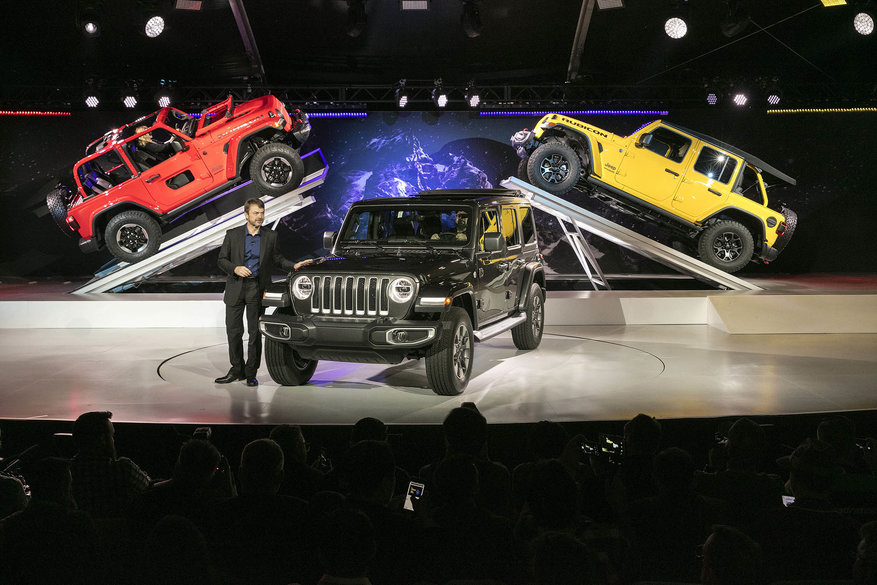Years of waiting and anticipation finally ended last Wednesday as Jeep officially unveiled its latest Wrangler redesign during the Los Angeles Auto Show.
The vehicle is Jeep’s third revision of the longstanding Wrangler brand, and for 2018 the company entirely rebuilt the thing – taking great care to retain Wrangler’s iconic look, while striving to update and upgrade many other features and elements.
And while the unveiling itself was sort of anti-climatic thanks to so many pictures and videos already available, it still was educational to be able to poke and prod the actual vehicle for an afternoon.
So let’s take a walk around and see what the new Wrangler has to offer.
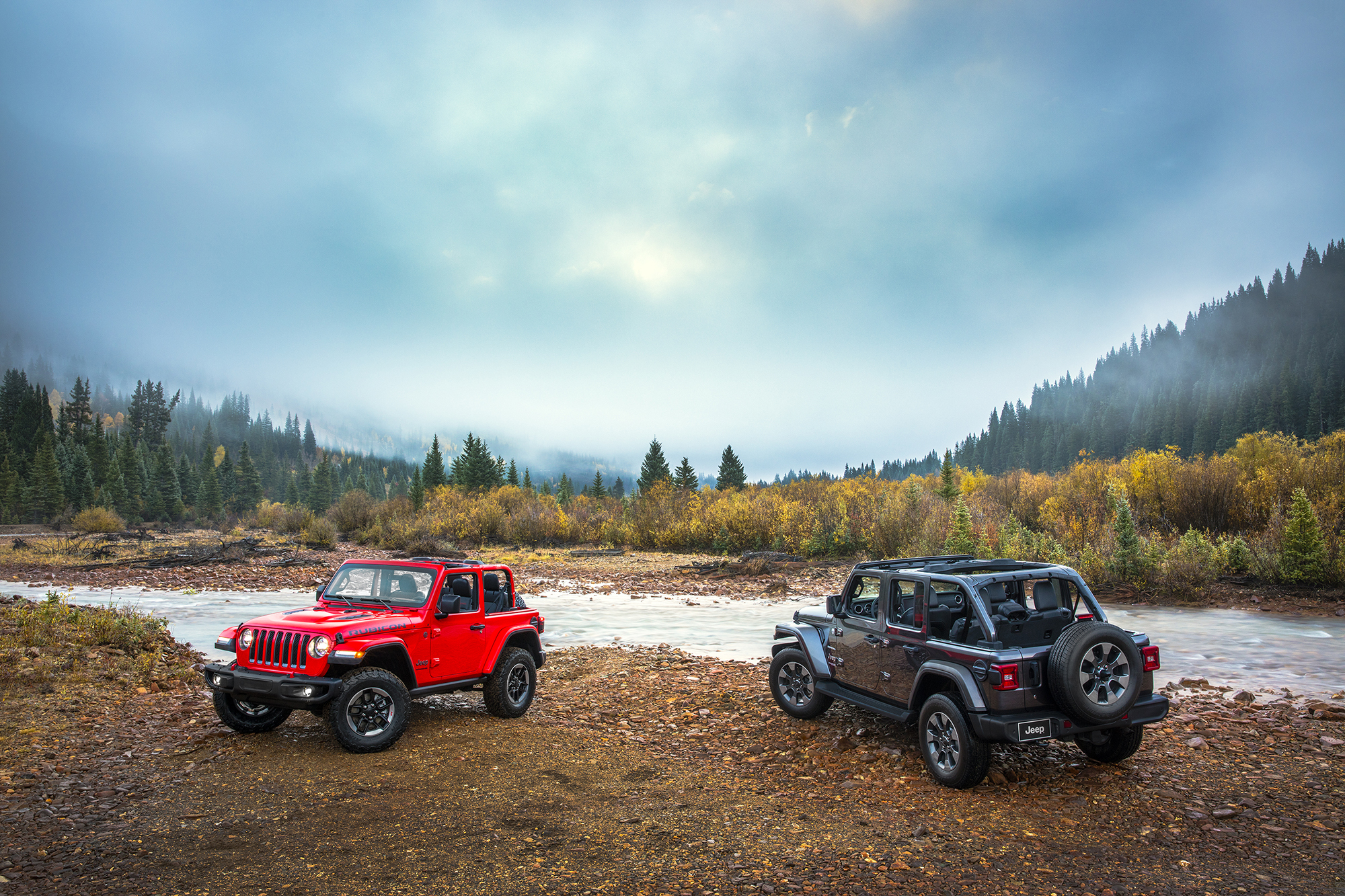
Trim Levels
Even though Jeep pretty much re-engineered its new Wrangler JL from the ground up, they did not change how the thing is packaged. The brand will still offer three separate trim levels, with some containing certain perks depending on what you are looking to purchase.
Entry level will still be the Sport series, and buyers can also choose from a base Sport or slightly upgraded Sport S, which will have a few more bells and whistles – such as air conditioning and power windows/mirrors. For many, the Sport tends to make the most sense as the vehicle is somewhat of a blank canvas that can be outfitted with aftermarket parts as needed, instead of settling for a higher (and more expensive) trim that may have unnecessary extras.
Sahara is the second trim version, and one Jeep still considers its ‘luxury’ level as it offers upgraded interior configurations like heated leather seats, dash trim and infotainment options, as well as exterior perks such as body-matched hardtop and fender flares. For 2018, the Sahara will also have an optional Selec-Trac two-speed transfer case with full-time four-wheel-drive available – a first for Wrangler.
Rubicon remains the top trim level and one specifically geared for those types into rock crawling. This version offers upgraded heavy duty axles, electronic lockers and sway bar disconnects, beefier and larger tires, redesigned hood, strong part time Rock-Trac 4x4 system with a superior 4:1 low gear for rock crawling, as well as a host of interior upgrades such as an Off Road pages tab on the UConnect Infotainment system, leather seats, heated mirrors and full interior LED lighting. Rubicon edition vehicles also receive special rocker guards designed especially for off-road enthusiasts.
Additionally, both Sport and Rubicon will still arrive in two- and four-door options, while Jeep scaled back Sahara to the four-door only. All models are slightly longer for 2018, with the two-door topping out at 1.4 inches and the four-door at 2.4 inches longer than the previous JK.
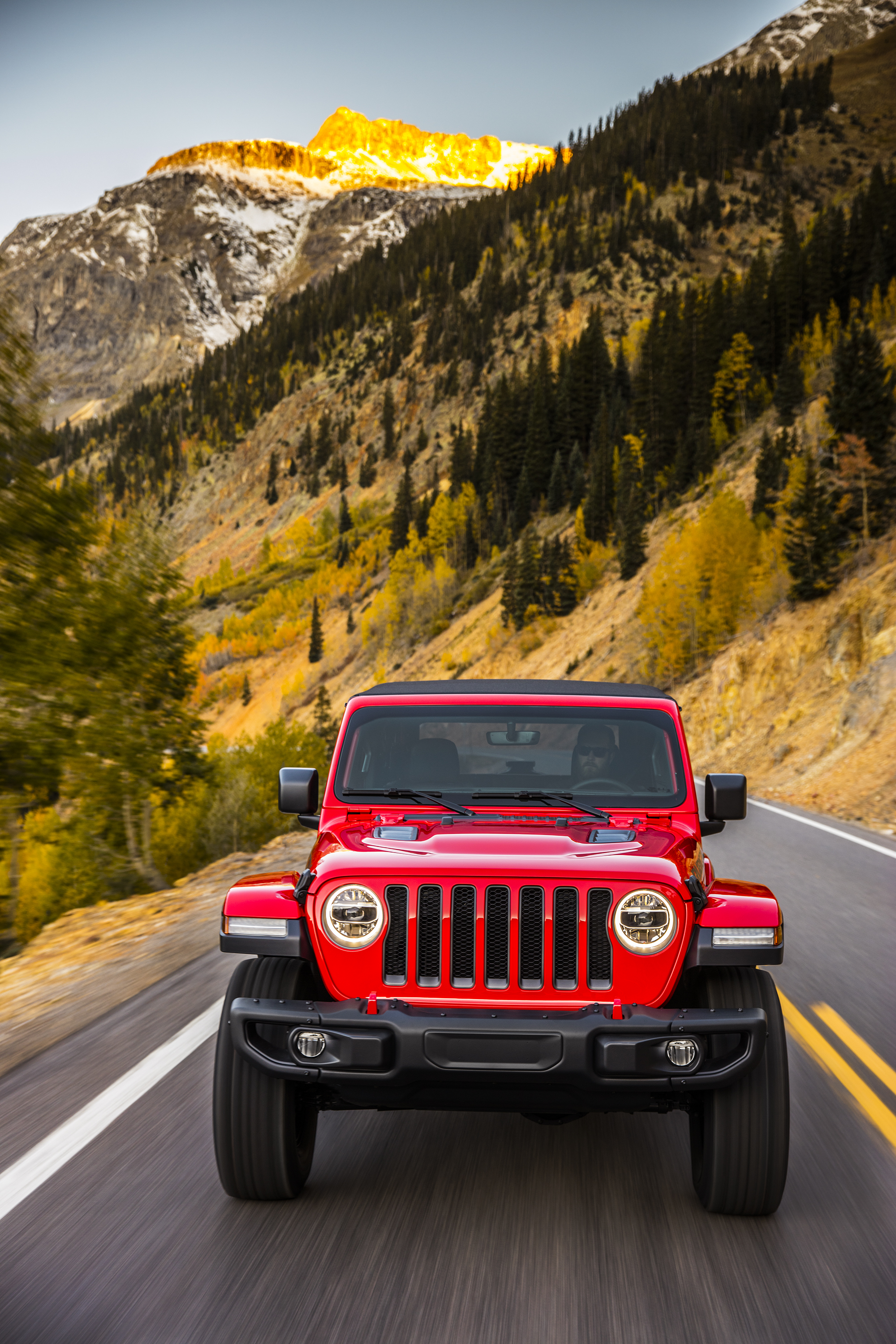
Front
For its front appearance, Jeep designers went back to the earlier CJ series vehicles to pull inspiration for the new JL Wrangler. The grille offers wider slot opening to pull more air into the vehicle’s engine, as well as headlights that leak into the grille slot area. These headlight openings are also slightly larger to throw out a bit more light. Plus, the stock halogen lights can be upgraded into the more popular LED version thanks to a LED lighting package. Rounding out the grille area is a subtle kink in the metal slats which harkens back to the older YJ style, and looks to provide some aerodynamic benefits, while the vehicle’s front bumper will offer removable ends for Sahara and Rubicon owners.
Designers have also moved the traditional Jeep logo off the grille, and moved signal lighting to the front fender face. For the hood, Jeep now uses aluminum instead of steel in all trim levels, while Rubicon series vehicles will have a ‘heat dispersion’ type with cowl venting. Holding down all hoods will be redesigned latches which now include a metal attachment, instead of rubber, for lasting durability.
For the windshield frame, designers also replaced the older steel version with aluminum and raked the angle back about 15 degrees which should provide increased aerodynamics and better fuel economy. Jeep Head of Design Mark Allen said they went through several different designs when looking at frame options, and felt this was the best looking one which retained the classic Jeep style, while also allowing for additional aerodynamics. By the way, the windshield still folds flat as in previous years, but the JL makes it easier as there are just four torx bolts that need removal in order to fold.
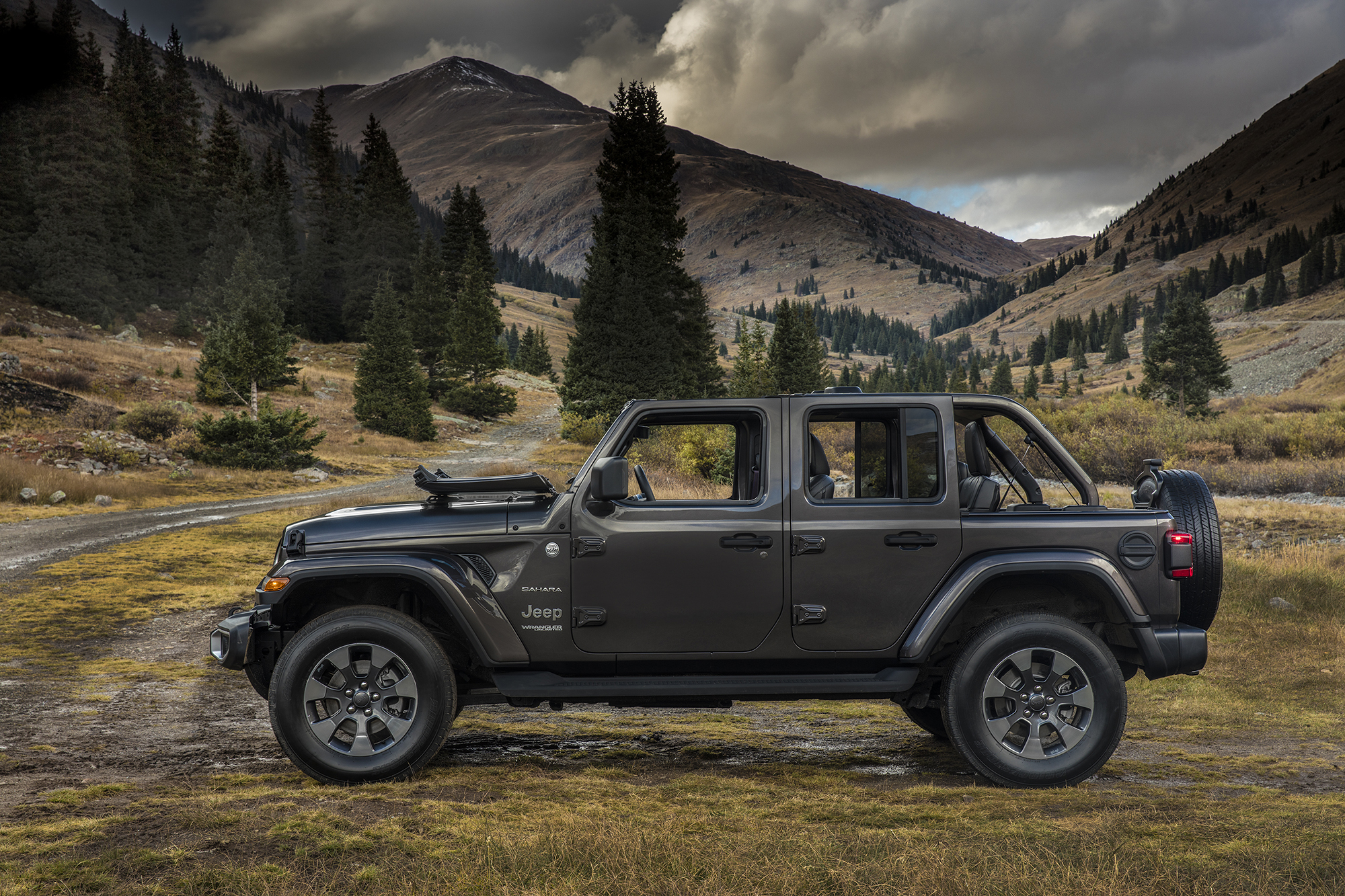
Sides
Two of the more noticeable JL Wrangler side changes involve the new vent openings slightly behind the front fenders, and the two-piece flares available on Sport S, Sahara and Rubicon. These flares are also designed with aluminum in order to remove some weight while giving the flares a bit more rigidity than previous editions. Fender vents, according to Allen, are fully functional and will both help vent the engine area, as well as reduce that annoying hood flutter which plagued the Wrangler JK.
In addition, Rubicon trim levels will have high clearance front flares to provide the extra clearance needed for larger wheels/tires.
The vehicle’s doors have been redesigned and are now self-closing, are now aluminum instead of steel and now feature redesigned hinges with an engraved ‘T50’ in order to remind owners the tool size needed for door removal. Doors also come with a ‘lift assist’ handle to make it easier to carry when off the vehicle. Plus, the door handles themselves have been changed out, and work with Jeep’s proximity keyless entry system.

Rear
Additional rear window visibility. That is what designers set out to do when they tackled the backside of the JL Wrangler. They pushed down the vehicle’s spare tire a bit, thus giving the driver a better viewing angle out the back window. Plus, a new federally-mandated backup camera is now mounted through the center of the spare tire, which is linked to the UConnect screen and activates when the vehicle is placed into reverse.
Another noticeable change is the JL Wrangler’s rear taillights, which now are somewhat larger and have a slight hourglass (some say Gerry can-ish) shape. LED taillights are also an option for everyone but the base Sport owner.
Rounding out some of the rear changes are redesigned tailgate hinges, a relocated license plate bracket and an new tailgate handle, which is designed to work in combination with the vehicle’s keyless entry system.
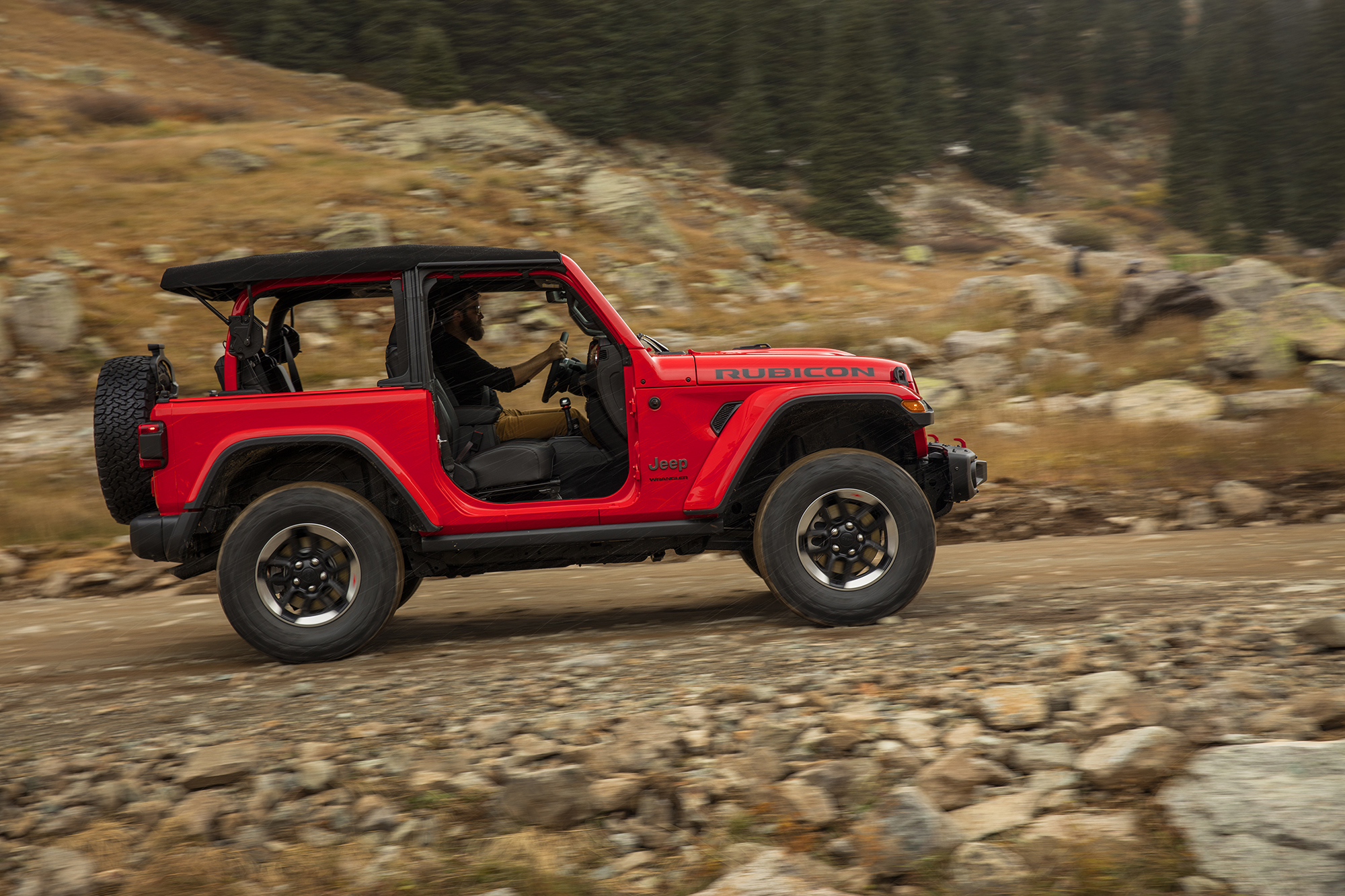
Tops
While the Jeep Wrangler has always been known for its soft or hardtop options, the 2018 JL Wrangler takes those tops and adds a level of refinement and ease of operation never seen before. For example, on all JL soft tops, two new bows and a rail system help quiet wind noise and allow for easier access to partial or fully open positions. Previously, manual clamps on each side needed to be activated before the soft top could be fully reclined.
Designers also added a soft top feature called ‘open air mode’ (shown above) where the all windows can be removed, but the top still left in place with back supports. Plus, when the top is fully reclined, it can be locked in place with a spring mechanism on both rear sport bars. When ready to pull back up, the springs release and easily move the top back into position without battling bulky hardware pieces.
Hardtop version JL Wranglers will arrive with lighter Freedom panels and larger side windows for added visibility, as well as redesigned latches for easier installation or removal. Hardtops also include rain gutters for added element protection. Sahara and Rubicon owners additionally have an option to color match the hardtop to the vehicle. Also, later in 2018, Jeep will offer an all new Sky One-Touch Powertop, which will have a electronically retractable canvas roof with lightweight removable rear side windows.
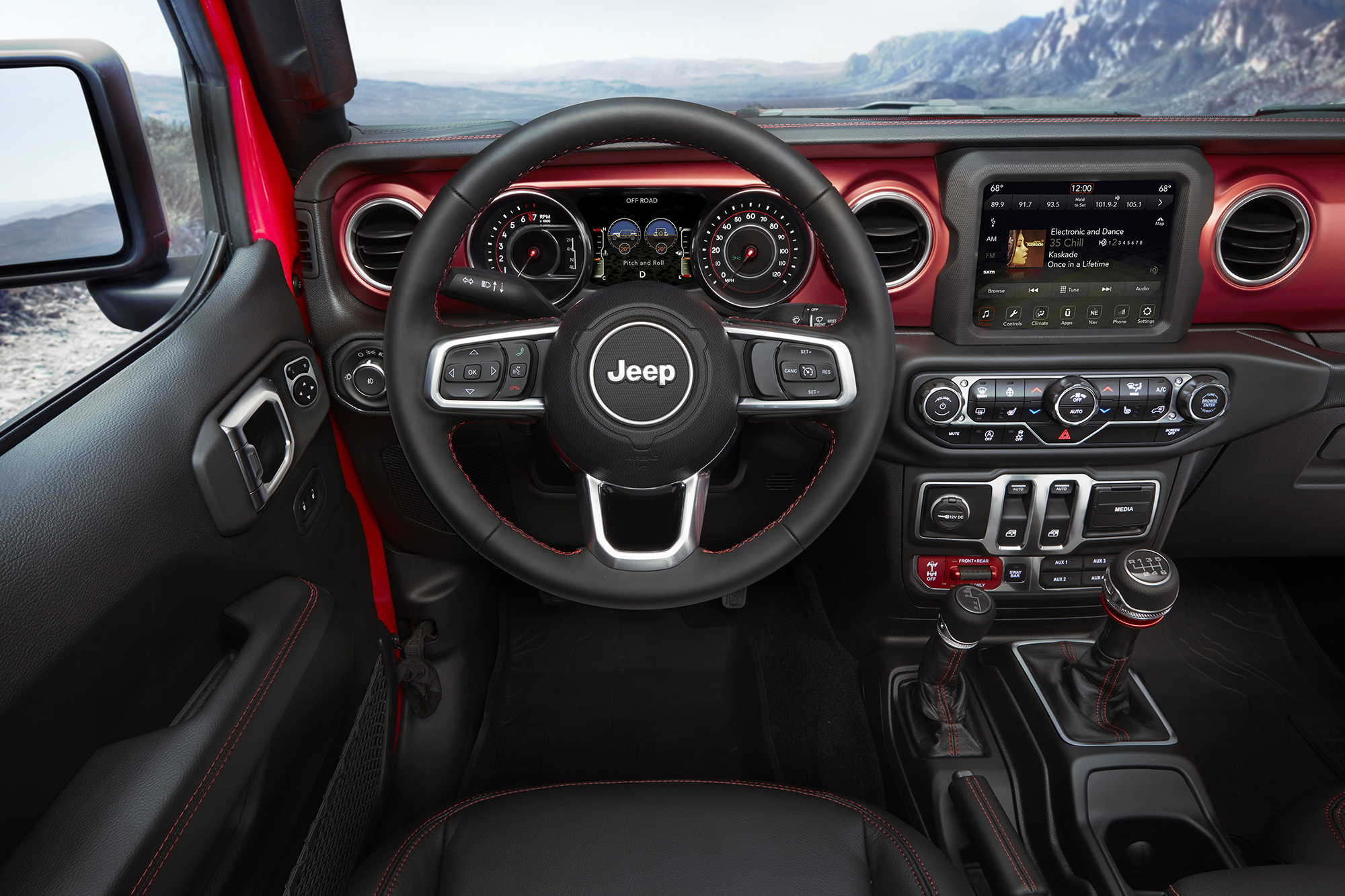
Interior
While the JL Wrangler’s exterior design remains static, for the most part, with those of the past, the vehicle’s interior is an entirely different story. Gone is the cheaper, plastic feel that marked previous editions, as designers added higher quality materials for a fit and finish deserving of a luxury vehicle, as well as integrated sport handles in the A- and B-pillars. They even ditched the old 'analog' metal key and ignition, for a push button starter.
The Jeep’s revised dash is now smoother and more horizontal than past versions and is color connected to the vehicle’s seat choice between red and black. The center stack was also cleaned up, but still contains all the usual suspects with climate and volume controls, mirror switches, power window controls and a media center with USB ports. Jeep has even added a four-switch auxiliary panel which gives owners a place to control needed accessories like lighting, winches, air lockers (non-Rubicon), or light bars.
Also taking over prime real estate in the center area is Jeep’s latest UConnect infotainment system, the 4C, which is offered in three moisture-resistant touchscreen sizes – 5-, 7-, or 8.4-inch, and is Apple Car Play and Android Audio compatible. This system will also have an optional 4G hotspot.
Just over the newly designed steering wheel, that Jeep says takes it cue from older CJ styles, is a new digital driver information cluster as well as mechanical gauges on each side. Depending on the vehicle model, the digital screen will be a 3.5- or 7-inch LED screen that displays, among other things, speed, tire pressure, current media played and pitch and roll. All display items can be controlled through integrated buttons in the steering wheel.
Other interesting interior design features include new transmission and transfer case shifters, foldable rear headrests, MOLLE pouches on the front seatbacks, redesigned center console with cupholders, interior LED lighting, multiple USB ports for front and rear passengers, new rear Trail Rail cargo management system and eight-speaker sound system that can option up to a nine-speaker version with rear Alpine subwoofer.

Engines
The new Wrangler JL will initially arrive with a slightly retuned 3.6L Pentastar engine, which pushes out 285 horsepower and 260 lb-ft of torque. This engine is rated for 18 mpg for city driving and 23 mpg highway – up from 16/20 in the JK edition.
Early in 2018, the company’s new turbocharged 2.0-liter four-cylinder engine will become available. Jeep calls this system eTorque, and it is a mild-hybrid belt starter generator engine designed to cut off the four-cylinder while decelerating or coasting to a stop. Regenerative braking stores energy for later use. This system also utilizes an electric motor to power the Wrangler from a start, marking the first application of Jeep’s new 48-volt hybrid battery system. The four-cylinder with eTorque makes 270 horsepower and 295 pound-feet of torque.
Down the road in 2019, Jeep also plans on adding a third powertrain option, a 3.0-liter turbodiesel V6. The company says this option will be an updated version of their EcoDiesel technology, and will make 260 horsepower and 442 pound-feet of torque. However, it will only be available on four-door Unlimited models.
Both the 3.6L and 3.0L engines will arrive with engine start-stop technology to aid fuel economy, and are equipped with a pollution-cutting technology known as exhaust gas recirculation. For those worried about stop/start while off-roading or just for everyday driving, Jeep has included a disable switch, however the technology is reactivated the next time owners start the vehicle. Fuel economy figures are not yet available for the four-cylinder or turbodiesel engines.
Transmissions
The 2018 JL Wrangler will come standard with a six-speed manual transmission, but many will look to upgrade to an all-new eight-speed TorqueFlite automatic transmission, which the company says has been specially designed to optimize engine output on the trail while providing smooth, efficient power delivery at highway speeds.
This transmission offers a unique set of two overdrive ratios which improve highway fuel economy and reduce overall noise, vibration and harshness levels, according to Jeep. It also uses sophisticated transmission software to determine the appropriate driving conditions and adjusts shift pattern in response to these driving conditions to offer the best possible fuel economy and drivability balance.
The Wrangler's new standard six-speed manual transmission features a unique design that employs new gear ratios for improved crawl ratio performance, a new gear pattern and a cable-operated design, which eliminates shifter vibration and improves sound isolation. It also has a revised shift pattern which helps shift accuracy, a more comfortable shifting position and 50-percent shorter throws than the outgoing Wrangler JK model. A 4.41 ratio spread offers improved fuel efficiency at faster speeds and delivers quick acceleration with smooth, precise shift quality, Jeep says.
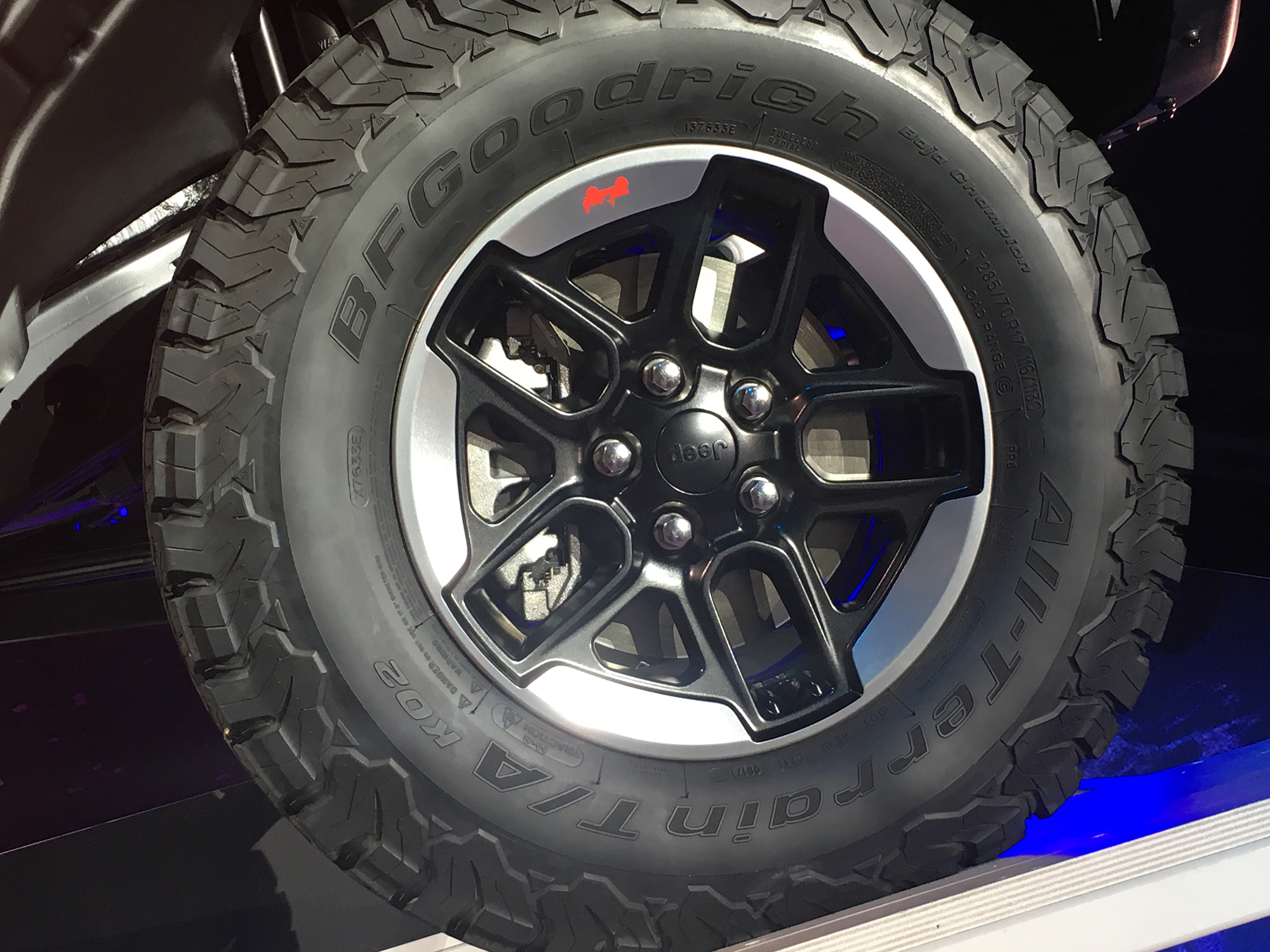
Tires/Wheels
Both the Sport and Rubicon series will arrive with traditional 17x7.5 wheels in a 5x5 lug pattern. However, Jeep did make a small change to the lug size, going from 12mm in the JK to 14mm. Sahara series vehicles will have a 18x7.5 wheel size.
Sport vehicles will also see P245/75R17 tires (31.5”), most arriving with all-terrain Goodyear Wrangler Adventure backed with Kevlar. Sahara editions jump to a P255/70R18 (32.1”), also mainly with all terrain Goodyear Wrangler Adventure tires. Rubicon versions will be an LT285/70R17C (32.7”) in a BF Goodrich KO2 All-Terrain.

Body
Headlining the 2018 JL Wrangler’s body is an all-new chassis featuring a 100-pound-lighter fully-boxed high-strength steel frame with five crossmembers and a hydroformed forward section. The design is bolstered with eight body mounts on the two-door and 10 on the four-door model. Galvanized frame components are also utilized for improved corrosion protection.
The JL Wrangler’s front axle has been moved forward resulting in a wheelbase increase of 1.4 inches on the two-door, and 2.4 inches on the four-door. New JL axles with Dana's AdvanTEK technology are also stronger than previous years, and feature Dana 30 (front) and 35 (rear) in the Sport/Sahara, and 44 (front and rear) for the Rubicon. These Rubicon axles have also been beefed up with thicker wall tubes and include 4.10 gears with Tru-Lok electric lockers that can be engaged on the fly up to 30mph in 4-Lo. Sport and Sahara editions will arrive with 3.45 gearing.
The new Wrangler’s control arms have also been lengthened to take advantage of that longer wheelbase, while shocks have been re-tuned for a softer ride. Rubicon editions, once again, receive an electronic sway bar disconnect and locker controls that can be activated from a new, easier to access center stack switch panel.
With a slightly wider base, the JL now employs a new electro-hydraulic steering system with a beefier steering box that allows for a more natural steering feel, while providing an improvement in fuel economy.
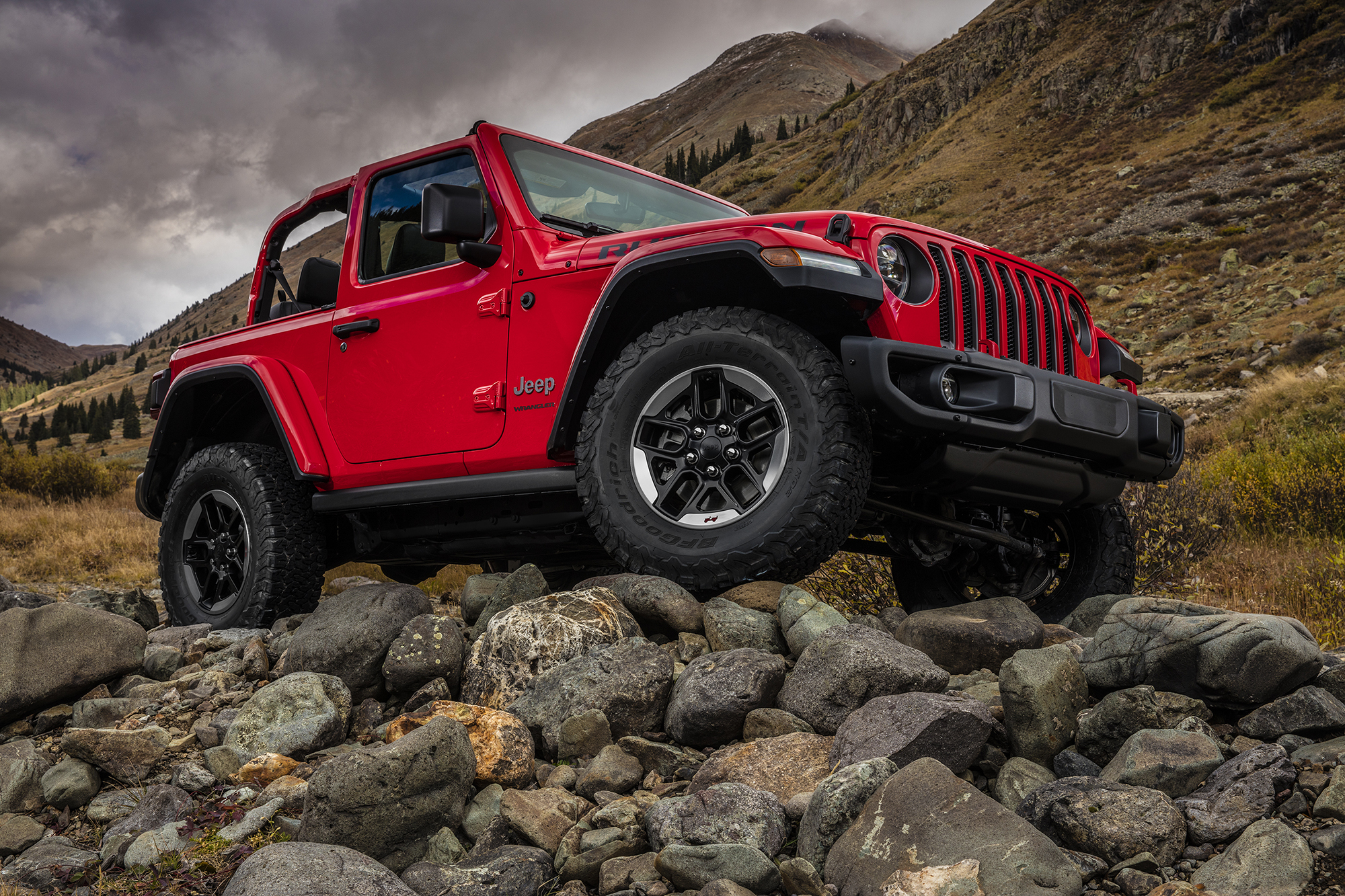
Off-Road
Just like every other Jeep Wrangler in history, the JL is designed so its owner can enjoy off road driving just as much as on road. But engineers have given the JL a bit more ‘teeth’ for off road performance than previous generations.
For starters, the JL will have slightly more ground clearance (9.7 inches for sport, 10 Sahara, 10.8 Rubicon than the earlier JK editions which were 8.3, 9.7,10), and will offer better approach (41.4-44 degrees depending on model), departure (35.9-37) and breakover angles (20.3-27.8) as well. Water fording depth is a stated maximum of 30 inches at 5 mph for all editions. Additionally, next generation Dana axles in all trim levels provide heavy duty strength right off the dealer lot over the JK, and are also ready to work with larger aftermarket tires and wheels should owners look to upgrade.
The Wrangler JL features two powerful 4x4 systems and - for the first time in Wrangler’s history – an optional two-speed transfer case just for Sahara, which offers full-time four-wheel drive and a 2.72:1 low-range gear ratio. This new Selec-Trac full-time transfer case is intuitive and allows drivers to simply switch on four-wheel drive, constantly sending power to the front and rear wheels, according to Jeep.
Standard on Sport and Sahara models is Jeep’s Command-Trac 4x4 system, which features a two-speed transfer case with a 2.72:1 low-range gear ratio, and a 48.18:1 crawl ratio on the six-speed manual, or 44.20:1 on the eight-speed automatic. Plus, the 4x4 system can be engaged in motion, up through 55 miles per hour and has the ability to be flat towed when shifted into neutral. The Dana 30 (front) and Dana 35 (rear) axles will arrive with a standard (and upgradable) 3.45 axle ratio.
On the JL Wrangler Rubicon, a beefier Rock-Trac 4x4 system features an enhanced NV241OR transfer case with a 4-lo ratio of 4:1. This ‘off road enthusiast’ trim level also offers improved articulation and further suspension travel versus the previous JK generation, the company says, thanks to an upgraded electronic sway-bar disconnect.
In its standard six-speed manual transmission, the Wrangler Rubicon has an improved crawl ratio of 84.2:1, while eight-speed automatic users will have a 77.2:1 ratio. Both Dana 44 front and rear axles utilize a 4.10 ratio.
In addition, both Command-Trac and Rock-Trac systems offer full-time torque management which, when enabled, provides optimal grip in low-traction conditions. An available Trac-Lok limited slip differential for both systems provides extra torque and grip during slippery, low-traction situations, such as driving over sand, gravel, snow or ice.
Two other helpful off-road features for Rubicon include front High Clearance flares that easily accommodate its larger 33” stock tires, as well as an Off-Road Pages section on its 8.4-inch UConnect Infotainment System which helps drivers monitor things like wheel articulation, transmission, oil and coolant temps, locker status, steering angle, pitch and roll, and sway bar disconnects.
-----
Jeep's latest Wrangler is now available to order from your local dealership, with arrival estimated around the middle of January.
For more specs on the 2018 Wrangler JL, check out our full list here.













